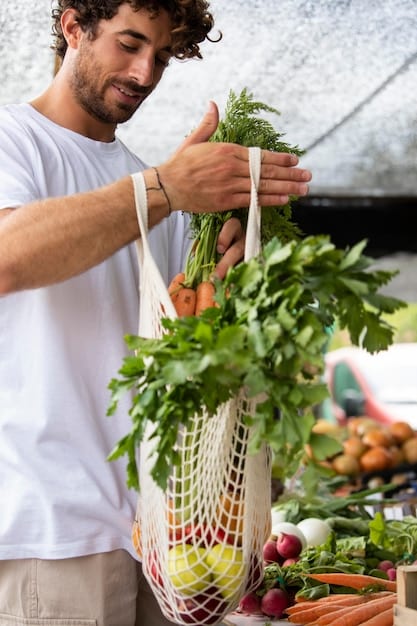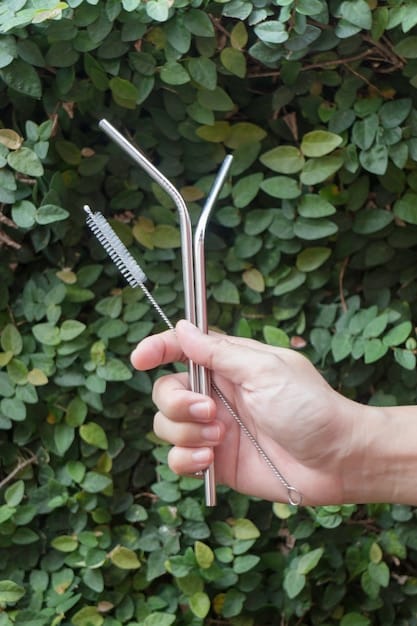Reduce Plastic Use: A 6-Month Guide to Cutting Consumption by 50%

Reducing plastic consumption by 50% in 6 months involves a strategic approach, focusing on conscious purchasing, reusable alternatives, reducing reliance on single-use plastics, and actively supporting sustainable habits in daily routines.
Are you concerned about the environmental impact of plastic and wondering how to reduce your plastic consumption by 50% in 6 months? It’s more achievable than you might think and a significant step towards a more sustainable lifestyle. Let’s explore manageable strategies to help you drastically shrink your plastic footprint.
Understanding Your Current Plastic Use
Before diving into solutions, it’s crucial to understand where you’re using the most plastic. This awareness will help you target your efforts effectively and measure your progress towards reducing plastic waste.
Conduct a Plastic Audit
Start by tracking all the plastic items you use in a week. This includes packaging, disposable utensils, bottles, and bags. Be thorough and note everything down.
Identify Key Culprits
Once you have a list, identify the biggest contributors to your plastic waste. Common culprits include single-use plastic bags, takeaway containers, bottled water, and packaged snacks.
- Check your kitchen: Look in your trash and recycling bins to see what plastic items you discard most often.
- Bathroom audit: Pay attention to plastic packaging from personal care items like shampoo, soap, and toothpaste.
- On the go: Note the plastic items you use outside your home, such as coffee cups, straws, and food packaging.
By analyzing your plastic use, you can pinpoint the areas where you can make the most significant changes, setting a realistic foundation for reducing plastic consumption.
Switch to Reusable Alternatives
One of the most effective ways to reduce plastic consumption is by replacing single-use items with reusable alternatives. This simple switch can dramatically decrease the amount of plastic waste you generate daily.

Reusable Shopping Bags and Produce Bags
Keep a set of reusable shopping bags in your car or by the door so you always have them handy. Also, switch to reusable produce bags for fruits and vegetables to avoid plastic bags at the grocery store.
Reusable Water Bottles and Coffee Cups
Invest in a high-quality reusable water bottle and coffee cup. These are easy to carry around and can save a significant amount of plastic over time. Many coffee shops even offer discounts for bringing your own cup.
Reusable Food Storage Containers
Replace plastic food storage containers and plastic wrap with reusable glass or stainless steel containers and beeswax wraps. These alternatives are not only better for the environment but also often safer for your health.
Switching to reusable alternatives requires an initial investment, but the long-term environmental and economic benefits make it a worthwhile endeavor, significantly aiding your journey toward reduced plastic consumption.
Refuse Single-Use Plastics Whenever Possible
Being proactive about refusing single-use plastics is a powerful way to reduce your plastic footprint. This involves making conscious decisions to avoid unnecessary plastic items in your daily routine.
Say No to Straws and Utensils
Politely decline straws, plastic cutlery, and disposable cups when ordering drinks and takeout food. Carry your own set of utensils if you frequently eat on the go.
Avoid Over-Packaged Products
Choose products with minimal packaging or opt for items packaged in recyclable materials like glass or cardboard. Support companies that prioritize sustainable packaging options.

- Bulk buying: Purchase items in bulk to reduce the amount of individual packaging.
- Shop at farmers markets: Farmers markets often offer fresh produce without plastic packaging.
- Read labels: Look for products with eco-friendly certifications and minimal plastic content.
By actively refusing single-use plastics, you send a message to businesses that consumers value sustainability, encouraging them to adopt more eco-friendly practices. This mindful approach is essential for achieving a substantial reduction in plastic usage.
Embrace DIY and Homemade Alternatives
One creative and effective way to reduce plastic consumption is by embracing DIY and homemade alternatives for various products. This not only cuts down on plastic packaging but also allows you to control the ingredients you use.
Homemade Cleaning Products
Create your own cleaning solutions using simple ingredients like vinegar, baking soda, and essential oils. These homemade cleaners are effective, non-toxic, and eliminate the need for plastic bottles.
DIY Personal Care Products
Make your own personal care items such as shampoo, conditioner, and body wash. There are numerous recipes available online that use natural ingredients and reduce plastic packaging waste.
Homemade Food Items
Prepare your own snacks, sauces, and condiments instead of buying packaged versions. This reduces plastic packaging and allows you to avoid processed ingredients.
Adopting DIY and homemade alternatives is a fun and rewarding way to reduce plastic in your life while also promoting healthier habits.
Support Businesses Committed to Sustainability
Your purchasing power can drive change. Supporting businesses committed to sustainability encourages more companies to adopt eco-friendly practices and reduce their plastic use.
Choose Brands with Eco-Friendly Packaging
Support brands that use minimal plastic in their packaging or opt for sustainable alternatives like glass, aluminum, or biodegradable materials. Look for companies with clear commitments to reducing their environmental impact.
Shop at Zero-Waste Stores
Visit zero-waste stores that offer products in bulk, allowing you to bring your own containers. These stores minimize packaging and promote sustainable consumption.
- Research companies: Look for businesses with transparent sustainability policies.
- Read reviews: Check what other customers say about a company’s eco-friendly practices.
- Ask questions: Engage with businesses and inquire about their efforts to reduce plastic use.
By consciously supporting businesses committed to sustainability, you amplify your impact and help create a market that values environmental responsibility.
Track Your Progress and Stay Motivated
Monitoring your progress is essential to stay motivated and ensure you’re on track to reduce your plastic consumption by 50% in 6 months. Tracking allows you to see the tangible impact of your efforts and make adjustments as needed.
Keep a Plastic Reduction Journal
Record your plastic consumption each week and note the changes you’ve made. This journal will help you visualize your progress and identify areas where you can improve.
Set Realistic Goals
Break down your 6-month goal into smaller, achievable milestones. Celebrate each success to maintain momentum and stay motivated.
Share Your Journey
Connect with others who are also trying to reduce their plastic consumption. Sharing tips, challenges, and successes can provide ongoing support and inspiration.
Tracking your progress and staying connected with a community of like-minded individuals will empower you to reach your goal and continue making sustainable choices. Small changes can add up to significant reductions in plastic waste, creating a positive impact on the planet.
| Key Concept 💡 | Brief Description |
|---|---|
| 🛍️ Reusable Bags | Always bring reusable bags for shopping to avoid plastic. |
| 🥤 Refuse Straws | Politely decline plastic straws and use a reusable alternative. |
| 🧴 DIY Products | Make your own cleaning and personal care products to reduce packaging. |
| 🌍 Eco-Businesses | Support companies with sustainable packaging and practices. |
Frequently Asked Questions
▼
Common sources include single-use plastic bags, food packaging, plastic water bottles, and personal care product containers. Identifying these sources helps in targeting reduction efforts.
▼
Politely decline straws, utensils, and plastic cups. Bring your own reusable containers for leftovers and support restaurants committed to sustainable practices.
▼
Use vinegar and water for general cleaning, baking soda for scrubbing, and essential oils for fragrance. These are effective, natural, and reduce plastic packaging waste.
▼
Research companies online, read customer reviews, and look for certifications like B Corp. Support businesses with transparent sustainability policies and eco-friendly packaging.
▼
Keep a journal to record your plastic usage each week and note the changes you’ve made. Set realistic goals and celebrate each success to stay motivated and on track.
Conclusion
Reducing your plastic consumption by 50% in 6 months is an achievable goal that requires conscious effort and consistent dedication. By understanding your plastic use, switching to reusable alternatives, refusing single-use plastics, embracing DIY options, supporting sustainable businesses, and tracking your progress, you can significantly reduce your environmental impact and contribute to a more sustainable future.





